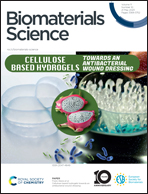Antiviral functionalization of a polypropylene nonwoven textile structure as a self-decontaminating layer for respiratory masks
Abstract
The aim of this work was to develop a filtering biocidal polypropylene (PP) nonwoven textile structure to block and inactivate airborne bacteria and viruses. PP filters were functionalized with a cyclodextrin (CD)-polycarboxylic acid-crosslinked polymer (PP-CD) through a pad/dry/curing process, and were then activated by padding in an alkyl dimethyl benzalkonium chloride (ADBAC) solution. The textile finishing process parameters were optimized with the perspective of mass production, considering the threshold temperature necessary for provoking crosslinking and the limitation of the low thermal stability of PP. The use of an aqueous solution containing hydroxypropyl-β-cyclodextrin (HPβCD), 1,2,3,4-butanetetracarboxylic acid (BTCA), ammonium hypophosphite (AH), and a surfactant allowed immobilization of the optimal quantity of cyclodextrin polymer under curing for 5 minutes at 125 °C without affecting the nonwoven PP structure. The presence of CD drastically increased the sorption of ADBAC on the textiles. There was leaching of ADBAC at the first rinsing and then satisfactory fastness at the second and third rinsings, revealing adsorption mechanisms by weak physical interactions, ionic interactions, and inclusion of ADBAC inside the CD cavities. SEM revealed no clogging of the nonwoven pores, nor any increase in the air flow resistance, as evaluated by pressure drop measurements. The filtration efficiency of particulate matter PM3.0 and PM0.5 was moderately affected, in contrast to that of PM0.3, which greatly decreased due to the loss of the electrostatic charge of the filter upon the functionalization process. Bactericidal tests resulted in a reduction of 3 log10 against Staphylococcus aureus, and for virucidal tests on human coronavirus HCoV-229E, there was a reduction of 3.4 log10, with both strains undergoing 20 minutes of contact. Finally, the filter we developed is manufacturable by a scalable process, and because of its filtration and biocidal performances, it is a choice material as a self-disinfecting layer in the fabrication of facepiece respirators.

- This article is part of the themed collection: 32nd Annual Conference of the European Society for Biomaterials, 2022


 Please wait while we load your content...
Please wait while we load your content...